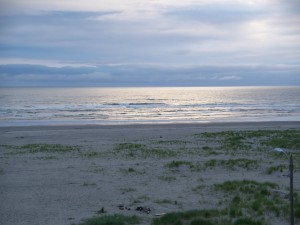 We finally reached the pristine Oregon Coast on one of the first warm days of the year. We piled into our 5th floor, ocean-facing hotel room, opened all the sliding doors and windows, sat down, and watched the water. What is it about the sea that makes me want to stop and stay?
We finally reached the pristine Oregon Coast on one of the first warm days of the year. We piled into our 5th floor, ocean-facing hotel room, opened all the sliding doors and windows, sat down, and watched the water. What is it about the sea that makes me want to stop and stay?
It was here, finally, that I was able to find restaurants that served local, organic foods. What a relief! I don’t think I could handle even one more processed, food-service meal. Blech.
Portland, also, has many fabulous restaurants serving local, organic foods which you can easily find online. However, we didn’t stay there long enough to sample very much. I’ve visited Portland many times in the past and enjoyed so many good meals there. They even have a chain of local, organic burger joints which I quite like, called Burgerville. The last time I was there, they were baking organic shortcakes to go with the in-season strawbwrries they had just received from the farm that morning. Yummy!
My favorite place to go in Portland is New Seasons Market. They are so much more than just organic grocery stores. When you walk in, the first thing you see is the Solutions Counter, usually staffed by a nutritionist or chef. There, you can find what’s in season, get help with a nutrition question, or discover recipes for the produce you are buying that day. Amazing! Then you walk into the store proper, which has a bakery, a meat counter, a cheese counter, and many other fully staffed departments where they make value-added products, in-house. You can meet the baker who made the loaf of bread from the grain grown by a local farmer. You just can’t do that anywhere else. I really like the Policies page on their website. Under Special Requests Policy, for example, it simply says “Yes”.
After a couple of days lounging on the beach, drinking fair-trade coffee, watching sand castles being built and then washed away by the tide, we decided that we missed all our animals just too much and that we needed to go home. (Sigh.) It was time.
 The route we took was across the mouth of the Great Columbia River, which is just an awesome sight. The Astoria-Megler Bridge, which spans the river at that point, is 4.1 miles long. The part you see to the left is tall enough for very large container ships to pass under. Truly, the Columbia is one of the wonders of the world.
The route we took was across the mouth of the Great Columbia River, which is just an awesome sight. The Astoria-Megler Bridge, which spans the river at that point, is 4.1 miles long. The part you see to the left is tall enough for very large container ships to pass under. Truly, the Columbia is one of the wonders of the world.
As soon as I got back to the Puget Sound, I got stuck in a traffic jam. I’d completely forgotten about those. I’ve had better welcomings.




